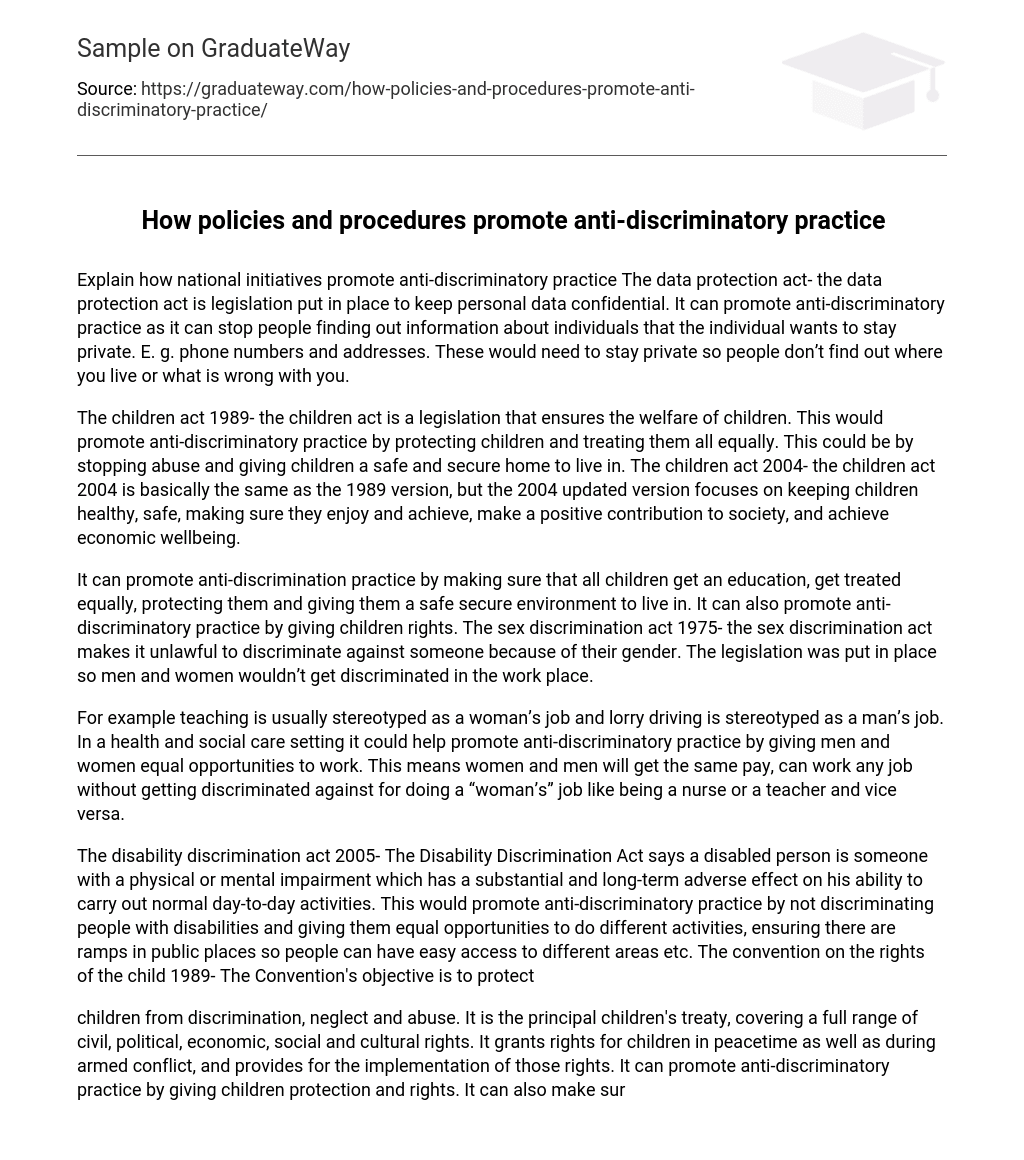Explain how national initiatives promote anti-discriminatory practice The data protection act- the data protection act is legislation put in place to keep personal data confidential. It can promote anti-discriminatory practice as it can stop people finding out information about individuals that the individual wants to stay private. E. g. phone numbers and addresses. These would need to stay private so people don’t find out where you live or what is wrong with you.
The children act 1989- the children act is a legislation that ensures the welfare of children. This would promote anti-discriminatory practice by protecting children and treating them all equally. This could be by stopping abuse and giving children a safe and secure home to live in. The children act 2004- the children act 2004 is basically the same as the 1989 version, but the 2004 updated version focuses on keeping children healthy, safe, making sure they enjoy and achieve, make a positive contribution to society, and achieve economic wellbeing.
It can promote anti-discrimination practice by making sure that all children get an education, get treated equally, protecting them and giving them a safe secure environment to live in. It can also promote anti-discriminatory practice by giving children rights. The sex discrimination act 1975- the sex discrimination act makes it unlawful to discriminate against someone because of their gender. The legislation was put in place so men and women wouldn’t get discriminated in the work place.
For example teaching is usually stereotyped as a woman’s job and lorry driving is stereotyped as a man’s job. In a health and social care setting it could help promote anti-discriminatory practice by giving men and women equal opportunities to work. This means women and men will get the same pay, can work any job without getting discriminated against for doing a “woman’s” job like being a nurse or a teacher and vice versa.
The disability discrimination act 2005- The Disability Discrimination Act says a disabled person is someone with a physical or mental impairment which has a substantial and long-term adverse effect on his ability to carry out normal day-to-day activities. This would promote anti-discriminatory practice by not discriminating people with disabilities and giving them equal opportunities to do different activities, ensuring there are ramps in public places so people can have easy access to different areas etc. The convention on the rights of the child 1989- The Convention’s objective is to protect
children from discrimination, neglect and abuse. It is the principal children’s treaty, covering a full range of civil, political, economic, social and cultural rights. It grants rights for children in peacetime as well as during armed conflict, and provides for the implementation of those rights. It can promote anti-discriminatory practice by giving children protection and rights. It can also make sure that children will be given somewhere safe to be; not near any war zones and hazardous areas which could cause ill- health.
Race relations act 2000- The Race Relations Act (RRA) 1976 amended 2000 makes it unlawful to treat a person less favourably than another on racial grounds. These cover grounds of race, colour, nationality (including citizenship), and national or ethnic origin. It can promote anti-discriminatory practice by making sure individuals from a different race get equal opportunities to get jobs, homes, practice their religion and have rights to have an education, medical treatment, and to get fair and equal pay to others of that job.
Age discrimination act- Age discrimination involves treating someone (an applicant or employee) less favorably because of his age (excluding people under the age of 18). The act promotes anti-discriminatory practice by giving individuals of all age’s equal rights. It promotes anti-discriminatory by giving people of different ages the right to work and to get the same treatment as others.





